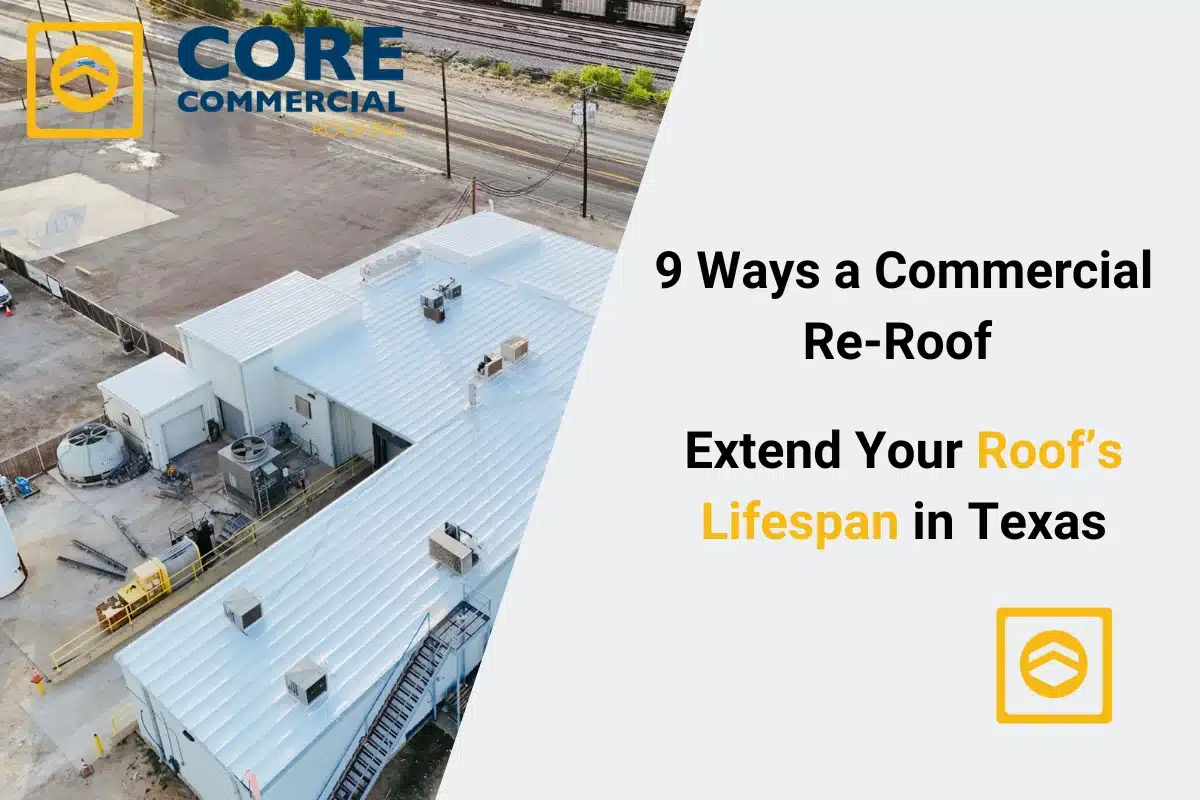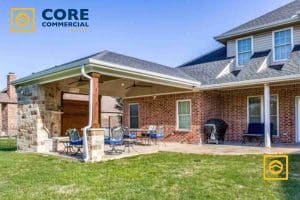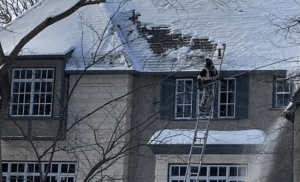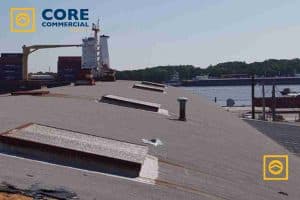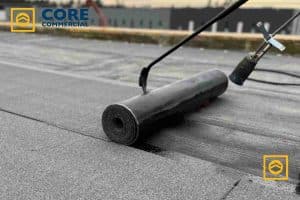Texas weather can be brutal on commercial roofs. Between scorching summers, sudden hailstorms, high winds, and heavy rains, even a strong roof will eventually show signs of wear. But needing work doesn’t always mean you have to start over with a complete tear-off and replacement. A commercial re-roof is the process of installing a new roof layer over the existing one when conditions allow. It can add years, even decades, to your roof’s life without the cost and disruption of a total replacement. The most effective ways we’ve seen this work is through modern reflective re-roofing systems, which cut heat damage and lower energy bills at the same time. In this article, we’ll explore nine practical ways a commercial re-roof can extend your roof’s lifespan in Texas. That helps you protect your building, lower costs, and avoid sudden roofing emergencies.
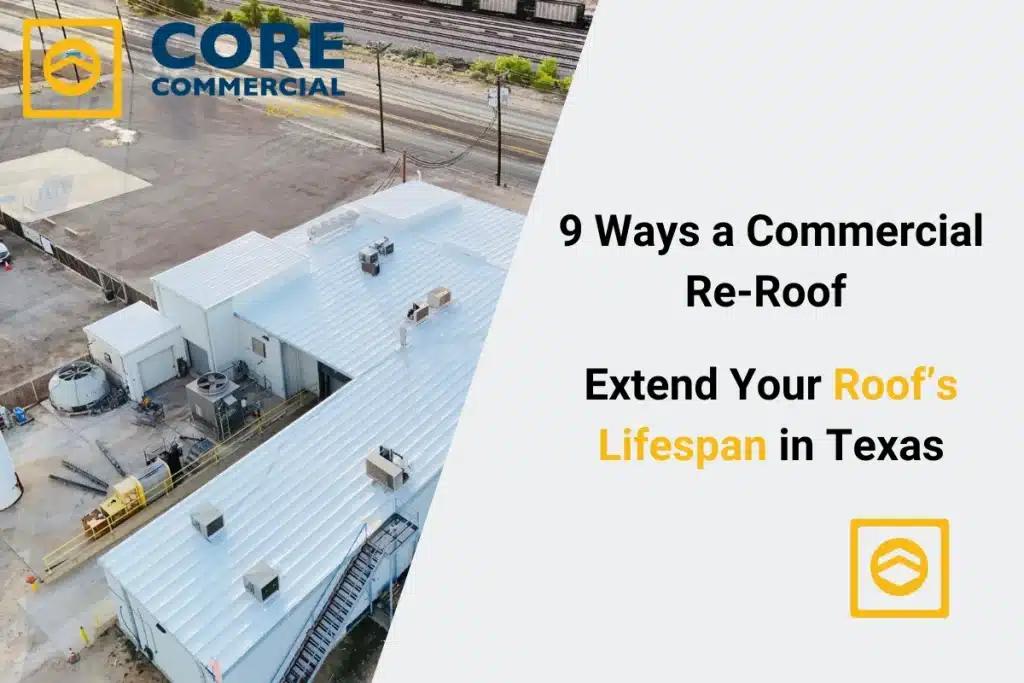
Table of Contents
1. Adds a Protective Layer That Shields Against Harsh Weather
A commercial re-roof is like giving your building a new suit of armor. Instead of removing the old roofing system, a qualified contractor installs a new layer on top of the existing one — provided the current roof is in stable condition. This new layer acts as a shield against intense sunlight, driving rain, hail, and strong winds.
For Texas businesses, this extra layer helps combat the state’s extreme temperature swings. In the summer, it reflects more heat and reduces thermal stress on the roof structure. In the winter, it adds insulation and keeps indoor spaces warmer. The result is a roof that can better handle the elements year after year without needing frequent major repairs.
2. Restores Waterproofing and Eliminates Hidden Leaks
Water is one of the most destructive forces for any commercial roof. Small leaks often go unnoticed for months, slowly damaging insulation, weakening roof decking, and allowing mold to grow in hidden spaces.
A re-roofing project includes installing new waterproof membranes, sealants, and flashing. These materials stop current leaks and prevent new ones from forming. In a state where thunderstorms can dump inches of rain in a single afternoon, stopping water intrusion is one of the fastest ways to add years to your roof’s life.
3. Improves Energy Efficiency and Lowers Utility Bills
In Texas, cooling a large commercial building can account for a significant portion of operating costs. A re-roof is the perfect opportunity to upgrade to reflective or “cool” roofing materials. These advanced systems can reduce rooftop temperatures by as much as 50°F.
Lower rooftop heat means your HVAC system works less to maintain comfortable indoor temperatures. Over time, this can save thousands on energy bills. It also reduces wear and tear on cooling equipment, further lowering maintenance expenses.
4. Slows Down Damage from UV Rays and Extreme Heat
The Texas sun doesn’t just heat up rooftops — it breaks them down. Ultraviolet radiation weakens roofing materials, causing them to crack, curl, or become brittle. Once these weak points develop, water and wind can quickly cause further damage.
Modern re-roofing materials are engineered with UV-resistant technology that significantly slows this aging process. By blocking UV damage and resisting heat degradation, your roof remains flexible, durable, and functional for many more years.
5. Strengthens Weak Structural Areas Before They Fail
A re-roof isn’t just about adding a new layer — it’s also an opportunity to identify and repair weak spots in the existing roof. Before the new material goes on, contractors can address sagging sections, areas prone to ponding water, or soft decking.
Reinforcing these vulnerable areas increases the roof’s ability to handle wind uplift, heavy rains, and hail impacts. This extra strength can mean the difference between a roof that weathers a Texas storm and one that requires an emergency repair.
6. Creates a Ready Surface for Future Rooftop Additions
If you’re considering solar panels, HVAC units, or other rooftop installations in the future, a re-roof is the perfect time to prepare for them. The new roofing surface will be smoother, stronger, and better able to support additional equipment.
By planning during your re-roof, you avoid having to redo sections later, which can save money and reduce business downtime. ypu
7. Brings Your Roof Up to Current Building Code Standards
Texas building codes change regularly to reflect new safety and weather-resistance standards. If your roof is older, it may no longer meet current requirements, which could affect insurance coverage or create liability issues.
Re-roofing allows you to incorporate modern materials and installation methods that comply with these updated codes. This not only protects your property but also ensures that inspections go smoothly when selling, leasing, or refinancing your building.
8. Reduces Insurance Risk and Can Lead to Lower Premiums
Insurance companies often charge more to cover older roofs because they are more likely to fail. In some cases, insurers may even refuse coverage if the roof is too old or damaged.
A re-roof signals to insurers that your property is better protected against weather-related damage. Some business owners find that their premiums decrease after completing a re-roof, especially when using impact-resistant or fire-resistant materials. You may try: metal roof installation
9. Minimizes Downtime and Business Disruption from Roofing Emergencies
Unexpected roof failures can force businesses to shut down temporarily, move operations, or relocate tenants. These disruptions can cost thousands in lost revenue and damage your reputation.
By investing in a re-roof before problems become severe, you avoid these last-minute emergencies. Your operations continue without interruption, and you gain peace of mind knowing your roof can handle Texas weather challenges.
Final Thoughts: Why a Re-Roof Can Be Your Best Long-Term Investment
For Texas business owners, a commercial re-roof offers a smart balance between cost, performance, and longevity. Instead of paying for a full replacement and dealing with extended downtime, you can add years to your existing roof’s life, improve energy efficiency, strengthen its structure, and reduce insurance risk.
The key is acting before small problems turn into big ones. A professional inspection can determine if your roof is a good candidate for re-roofing. By planning, you protect your property, budget, and business continuity for years to come.
FAQs
How does re-roofing extend a roof’s life in Texas?
Re-roofing adds a new layer that protects against the Texas sun, rain, and wind. It helps stop leaks, reflects heat, and prevents damage, making your roof last longer.
Is commercial re-roofing better than replacement?
Yes, re-roofing costs less and takes less time than full replacement. It strengthens your current roof, adds waterproofing, and keeps your business running.
What are the benefits of re-roofing in Texas heat?
Texas roofs face extreme heat. Re-roofing with reflective materials cuts rooftop temperatures, keeps buildings cooler, and lowers energy bills all summer long.
Can re-roofing lower energy costs in Texas?
Absolutely. Reflective materials used in re-roofing help cool your building naturally. This reduces air conditioner use and can save you money every month.
Does re-roofing stop roof leaks in Houston?
Yes, a re-roof seals up leaks by adding new waterproof layers. It protects your building from stormwater damage and mold, especially during Houston’s rainy season.
Is my business eligible for commercial re-roofing?
If your roof has only one layer and the structure is still strong, it likely qualifies for re-roofing. A professional inspection in Texas will confirm this.
Will re-roofing help meet Texas building codes?
It will. Many re-roof systems use updated materials that meet the latest codes. This helps with insurance, safety, and legal compliance in cities across Texas.
Can a re-roof lower my business insurance cost?
Yes. Insurance companies prefer newer, protected roofs. A fresh re-roof can reduce risk, which might help lower your premiums or get better coverage.
How does re-roofing protect against Texas storms?
It reinforces weak spots, stops leaks, and adds layers that resist wind and hail. This helps your building stay safe during harsh Texas weather.
Should I re-roof before adding solar panels?
Definitely. Re-roofing gives you a strong, stable surface. It’s smart to upgrade the roof before adding solar or HVAC systems to avoid future problems.

